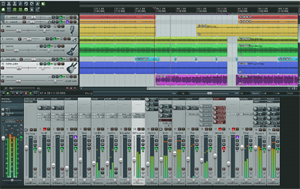
I’ve been saying that for your home studio, with Reaper software you also need an audio editing software program. It turns out that for most people in most situations, this is simply untrue. I know, crazy right? I’ve been giving out advice that may have been wrong. Gasp. For me, sadly, I think there is no going back; at least not easily. I started many moons ago using a program called Cool Edit Pro (now Adobe Audition), which had two “views” that you could toggle between; one for multitrack use and mixing, and one for audio file editing. When I was working in multitrack view and wanted to edit a file (which actually changes the underlying wave file in a process called “destructive editing”), I would click on the View toggle and presto! I was in the editing view. I worked like this for years.
Part of the reason I worked that way was that my computer was feeble, which is to say, normal. In order to treat a track in multitrack view with effects that could have done some of the same things that I was doing in the edit screen, I would have been using “non-destructive” editing. These treatments, in the form of effect plug-ins, didn’t actually do anything to the underlying wave file in the track. The effect would just plug into the track and affect whatever audio happened to be on that track. This kind of non-destructive editing eats up massive amounts of computer horsepower in a hurry, especially if you have several tracks and several effects running. It didn’t take much at all for my computer to simply raise the white flag and lie down in exhaustion. Destructive editing, especially if I saved a back-up of the original file, was the way to go for non-specialized computers.
Eventually, a program called Reaper came on the scene and had, as one of its biggest benefits, a streamlined architecture that ate up fewer computer resources than its fellows. I jumped on-board immediately and started doing a lot of my formerly-destructive editing tasks in Reaper (like compression, EQ and reverb) with no ill effects on my computer. But there were still things I did in Adobe Audition, mostly our of habit. Those were things like p-pop elimination, noise reduction, and final mix mastering. I still do that today.
But you almost certainly don’t have to use an external editor at all. I’ve been challenging my assumptions and habits and it turns out that for most readers of Home Brew Audio (we cater to recordists of voice over and musician alike here). I’m going to be doing some more checking up on this, just to fully convince myself, especially in the noise reduction arena. I’ll let you know what I find out. But if you’ve been confused in the past by my assertion that if you use Reaper, you’ll also need an external audio editor, please know that I have reversed (mostly) my thinking on that score.
Go forth and record AND edit with Reaper!